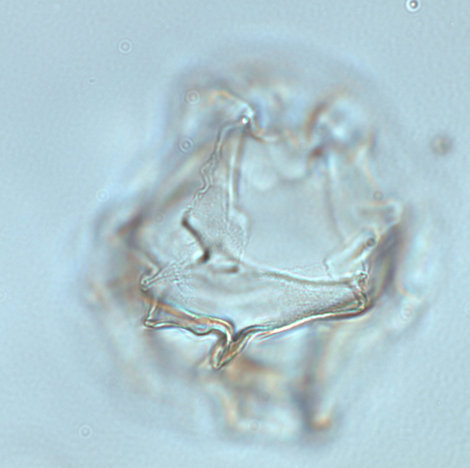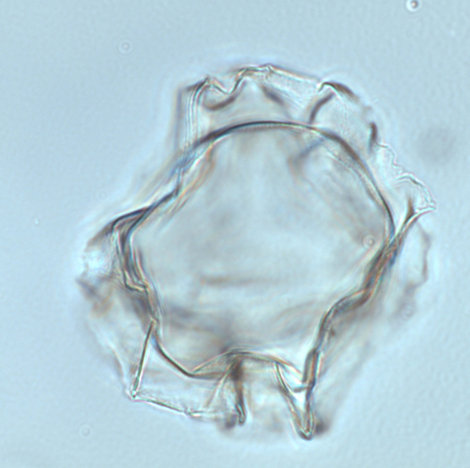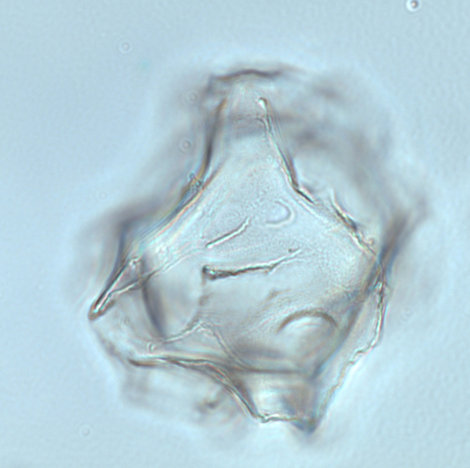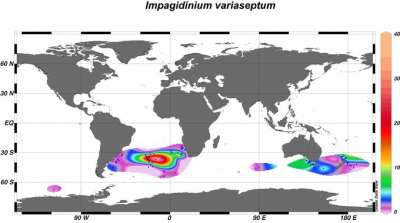Die Inhalte dieser Seite sind leider nicht auf Deutsch verfügbar.
Seitenpfad:
- Modern Dinocyst Key
- transparent cysts
- Paratabulation reflected by septa
- variable septa
- Impagidinium variaseptum
Impagidinium variaseptum
Zonneveld, K.A.F. and Pospelova V. (2015). A determination key for modern dinoflagellate cysts. Palynology 39 (3), 387- 407.

dorsal view
photo: Karin Zonneveld
locality: Namibian shelf (South Atlantic Ocean)
photo: Karin Zonneveld
locality: Namibian shelf (South Atlantic Ocean)

cross section
photo: Karin Zonneveld
photo: Karin Zonneveld

ventral view
photo: Karin Zonneveld
photo: Karin Zonneveld
Field Characteristics
Impagidinium variaseptum Marret et de Vernal 1997
Field characteristics:
Proximochorate cyst with a subspherical central body, a pronounced apical protuberance and a scabrate wall surface. Sutural suturocavate septa are more or less well developed, smooth to finely ornamented, of variable height, with raised bosses in gonal and intergonal positions. The septa show a proximal cavation and are indented distally. Precingular archeopyle (3”).
Dimensions: Cyst body: 47 x 75 µm; height of septa: 3 to 11 µm.
Comparison with other species:
This species can be separated by the other Impagidiniums through the cavateness of its septa. The rate of open space between the inner part of the septa and the inner cell wall can vary greatly from very pronounced over the complete septa to only present at the triple junctions. If the latter is the case it resembles Impagidinium sphaericum. However, the septa of I. variaseptum are always smooth to finely ornamented, without ruptures and holes. It can be easily distinguished from I. caspiense by the lack of low intertabular ridges that are characteristic for the latter species.
Field characteristics:
Proximochorate cyst with a subspherical central body, a pronounced apical protuberance and a scabrate wall surface. Sutural suturocavate septa are more or less well developed, smooth to finely ornamented, of variable height, with raised bosses in gonal and intergonal positions. The septa show a proximal cavation and are indented distally. Precingular archeopyle (3”).
Dimensions: Cyst body: 47 x 75 µm; height of septa: 3 to 11 µm.
Comparison with other species:
This species can be separated by the other Impagidiniums through the cavateness of its septa. The rate of open space between the inner part of the septa and the inner cell wall can vary greatly from very pronounced over the complete septa to only present at the triple junctions. If the latter is the case it resembles Impagidinium sphaericum. However, the septa of I. variaseptum are always smooth to finely ornamented, without ruptures and holes. It can be easily distinguished from I. caspiense by the lack of low intertabular ridges that are characteristic for the latter species.
Geographic Distribution
Geographic distribution based on :
Zonneveld et al., 2013. Atlas of modern dinoflagellate cyst distribution based on 2405 datapoints. Review of Palaeobotany and Palynology, v. 191, 1-197
Zonneveld et al., 2013. Atlas of modern dinoflagellate cyst distribution based on 2405 datapoints. Review of Palaeobotany and Palynology, v. 191, 1-197
Impagidinium variaseptum is a species characteristic for full marine, low productivity environments from the Southern Hemisphere temperate regions.

Distribution:
Impagidinium variaseptum is restricted to temperate regions of the Southern Hemisphere. Although it can be observed in coastal sites, highest abundances (up to 34%) occur in the open central part of the oceans.
Environmental parameters:
SST: 2.2 - 25.7°C (winter - summer) except for two sites in the Pacific sector of the Southern Ocean where winter SST: -1.5°C, SSS: 33.5 - 36.4 (summer - winter), [P]: 0.08 - 1.84 μmol/l, [N]: 0.04 - 25.8 μmol/l, chlorophyll-a: 0.06 - 2.2 ml/l, bottom water [O2 ]: 0.04 - 5.6 ml/l.
Abundances > 10% occur in regions with temperatures between 12.6 - 21.6°C (winter - summer).
Characteristically is abundant in oligotrophic settings although it is recorded from some sites where high nutrient concentrations but low productivity prevail.
Comparison with other records:
Impagidinium variaseptum has not been recorded from regions not covered by this Atlas.
Impagidinium variaseptum is restricted to temperate regions of the Southern Hemisphere. Although it can be observed in coastal sites, highest abundances (up to 34%) occur in the open central part of the oceans.
Environmental parameters:
SST: 2.2 - 25.7°C (winter - summer) except for two sites in the Pacific sector of the Southern Ocean where winter SST: -1.5°C, SSS: 33.5 - 36.4 (summer - winter), [P]: 0.08 - 1.84 μmol/l, [N]: 0.04 - 25.8 μmol/l, chlorophyll-a: 0.06 - 2.2 ml/l, bottom water [O2 ]: 0.04 - 5.6 ml/l.
Abundances > 10% occur in regions with temperatures between 12.6 - 21.6°C (winter - summer).
Characteristically is abundant in oligotrophic settings although it is recorded from some sites where high nutrient concentrations but low productivity prevail.
Comparison with other records:
Impagidinium variaseptum has not been recorded from regions not covered by this Atlas.


